USA
 USA CANADA . WYOMING UTAH . COLORADO MEXICA |
Dating back to the Eocene Period (54 to 37 million years ago), the Green River fossil beds are one of the most important in the United States of America. The first known excavations in the region took place in the 1850s. In 1856, the archaeologist Dr. John Evans announced the fish fossils he had collected in the region to the scientific world, and the Green River Formation thus entered the scientific literature.
The Green River is actually a tributary of the Colorado River. The Green River Formation itself is a mountain-lake basin consisting of an area spread over three separate states. Part of it lies to the east of the Uinta Mountains in northwest Colorado, and a wider part lies in southwest Wyoming. Green River's rock structure is made up of different strata, whose contents vary the deeper down one goes. Fossil distribution also varies. To date, fossils belonging to some 60 separate vertebrate groups have been found in digs in Green River and countless invertebrate fossils.

Canyonland National Park, Colorado
Ohio is a state with well-known fossil fields. Geological research has shown that some 510 million years ago, Ohio lay to the south of Ecuador. As the continents drifted and North America moved towards its present position, Ohio found itself underwater several times. That explains why a large number of fossils dating back to the Palaeozoic (543 to 251 million years ago) have been discovered in Ohio.
Another state with rich fossil beds is Utah. A great variety of fossils, from invertebrates to different marine organisms and from reptiles to mammals, has been unearthed in Utah. Microscopic fossils recently discovered in the Uinta Mountains have revealed that there are fossil beds in Utah dating to the Cambrian Period.
As is the case with fossils discovered in other regions of the world, all of them once again demonstrate that there is no difference between modern-day trout, skate, dragonflies, flies, spiders, crabs and turtles and similar creatures that lived millions of years ago. Living things have undergone no change in the intervening hundreds of millions of years—in other words, they did not undergo evolution. The fossil records refute evolution and once again confirm the fact of creation.
 A fossil research area in Wyoming |  A fish fossil found in Green River, Wyoming |
 Left, Kaibab limestone averages about 250 million years old and forms the surface of the Kaibab and Coconino Plateaus. Fossils that can be found in this layer are coral, mollusks, sea lilies, worms and fish teeth.. | 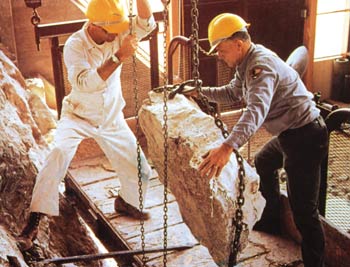 Right, transportation of the fossil. |
 |
Garfish Age: 54 to 37 million years old Hundreds of garfish fossils that have been collected give evidence that these still-living fish have remained unchanged for millions of years. The garfish pictured, between 54 and 37 million years old, is no different from those living in our seas today. This exact similarity is an inexplicable situation for Darwinists and once again proves the fact of creation. |
 |
Poplar Leaf Age: 54 to 37 million years old Darwinists try to explain the question of how plants emerged by using the concept of “chance.” They claim that an endless series of various plant species emerged, over the course of time and by chance, from one single original one-celled plant-which itself appeared as the result of chance. |
 |
Stingray Age: 54 to 37 million years old Stingrays are cartilaginous fish. In the face of a threat, they defend themselves with the stings on their tails. Their eyes are located above their flattened bodies and their mouths are underneath. Just like sharks, they find their food by using their sense of smell and by electrical senses. They generally live submerged on the ocean floor, with only their eyes and tails discernable. |
 |
Sardine Age: 54 to 37 million years If evolutionary claims were true, then there should be considerable differences between sardine fossils unearthed and those living today. There should be signs in sardine fossils of the so-called evolutionary process that Darwinists claim took place. However, no trace of any such thing has ever been found. Neither is it possible for any to be found in the future, because life is not, contrary to what evolutionists would have us believe, the product of blind coincidences. Almighty and Omniscient God created all living things. |
 |
Herring Age: 54 to 37 million years old "Living fossils" reveal that species have not evolved, but are created. Species have not attained their present body structure by chance, as evolutionists claim. They are all created flawlessly by Almighty God and have lived throughout their existence in the form they were created. |
 |
Crab Age: 50 million years old One striking feature about the fossil record is that, living beings have undergone no changes during all the geological periods. In other words, for tens of millions, and even hundreds of millions of years, creatures have remained just as they initially appeared in the fossil records. This is evidence that then and now, living beings have not evolved. |
 |
Perch Age: 54 to 37 million years old Perches are a kind of freshwater fish that can adapt to different environments and water temperatures. |
 |
Sumac Leaf Age: 54 to 37 million years old Like all other living beings, plant species also emerged fully formed, with their complex structures. That is to say, they were created with all their characteristics intact. Hundreds of thousands of plant fossils in geological strata prove this point. Evolutionists can not provide us with fossils that are half-pine, half-willow, half-moss, half-orchid, or half-carnation. On the other hand, hundreds of thousands of fossils demonstrate that willows have always been willows, pines have always remained as pines, spruces have always remained as spruces and plane trees have always remained as plane trees. Each of these fossils, millions of years old, refutes evolution. This sumac fossil, between 54 and 37 million years old, is another evidence revealing the Darwinists' deceptions. |
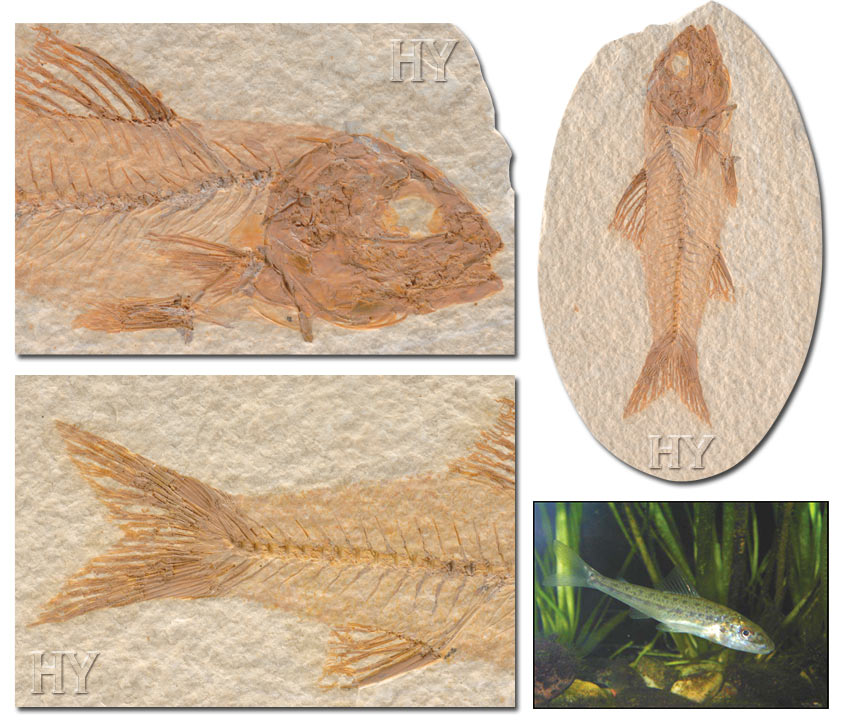 |
Trout-Perch Age: 54 to 37 million years old Trout-perches generally live in lakes. If a creature continues to survive in our day with all the flawless features it had millions of years ago, having undergone no changes, this is strong evidence invalidating the "gradual evolution" model advanced by Darwin. There exist not a few, but millions of such examples on Earth, that will prove this point. The trout-perch fossil here is just part of this evidence. |
 |
Two Herrings Age: 54 to 37 million years old Like all other living beings, herrings have undergone no change for millions of years. The structure of herrings that lived 54 million years ago and those of today are exactly the same. This refutes the evolutionist claim that living species gradually evolved from one another. |
 |
Trilobite Age: 380 million years old Trilobites are one of the most important sea creatures that lived in the Cambrian Period, leaving many traces in various parts of the world. One of the most astounding features of trilobites is their multi-lensed eye structure, consisting of countless units, each one of which is a lens. Just as the hexagonal "honeycomb" eyes of insects, each of these units functions as a single, independent lens. Each one perceives a separate image, and in the brain, these images unite into a whole. |
 |
Herrings Age: 54 to 37 million years old Pictured are herrings that probably were killed together because of a sudden burial. Their fossilized tails and fins show no signs of any damage. Their well-preserved eye sockets and bone structures once again show that evolution did not occur in any part of their geologic time. |
 |
Millipede Age: 300 million years old Pictured is a 300-million-year-old fossil millipede. This and other millipedes that lived 300 million years ago display not the slightest difference from today's millipedes. Like all other living beings, millipedes too did not evolve, but were created. |
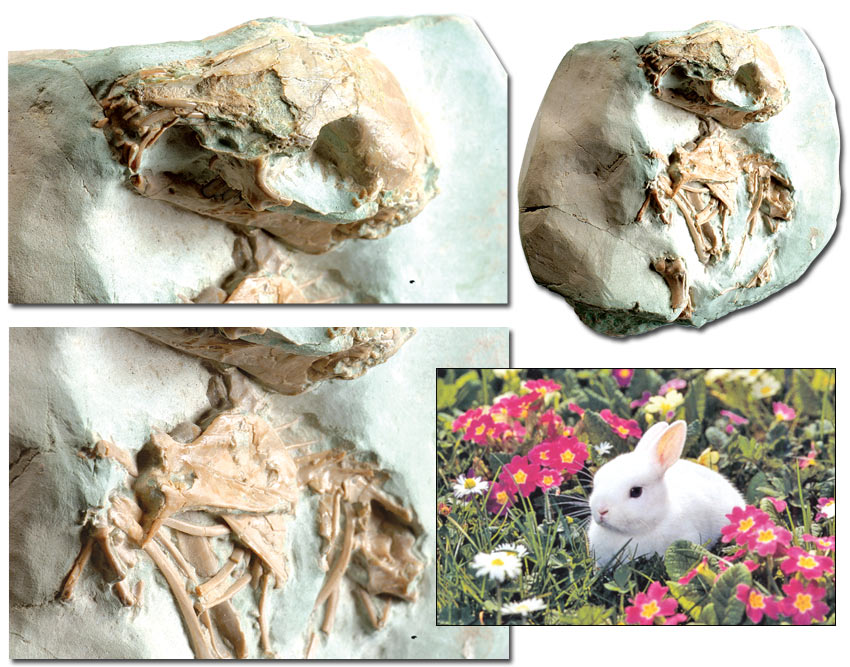 |
Juvenile Rabbit Age: 30 million years old 30-million-year-old fossils that are identical with creatures living today refute the theory of evolution. Fossil discoveries reveal that rabbits have always been rabbits. |
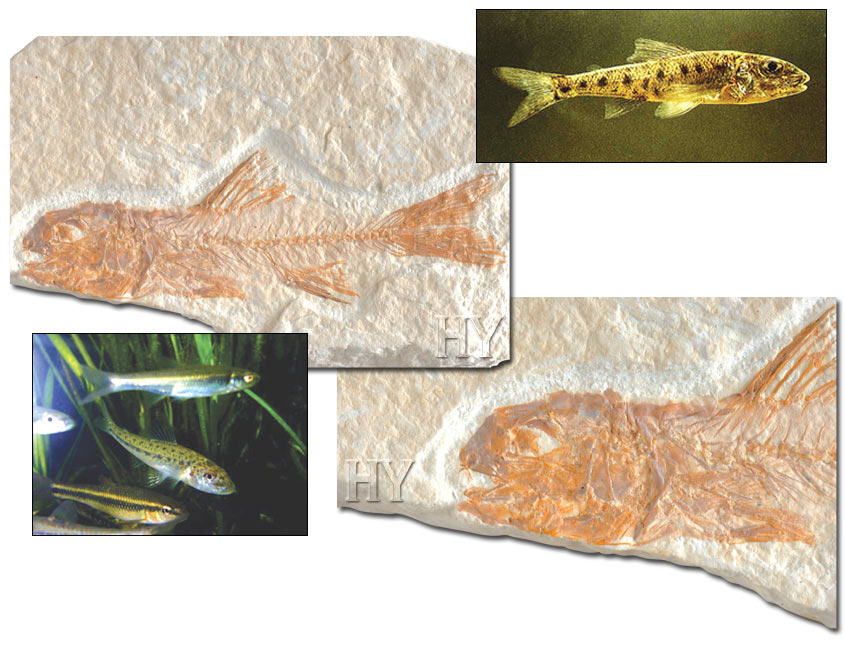 |
Trout-Perch Age: 50 million years old Trout-perches are of many different kinds. Almost all of them exist in fossil records, which show that they have stayed the same for millions of years and have not evolved. |
 |
Sea Urchin Age: 295 million years old Pennsylvanian sea urchins are echinoderms that can be found today in all seas of the world. Sea urchin fossils dating back 300 million years reveal that these invertebrates with their complex structures have existed for millions of years. During all that time, no change have occurred in their structure, and they have undergone no intermediate stages. |
 |
Sycamore Leaves Age: 50 million years old Examining the fossil history and structural features of plants living on land, we come across facts that are incompatible with what the theory of evolution asserts. Plants shown in almost all biology books have no fossil records that verify the so-called evolutionary process. Most of today's species have left very satisfactory remains in the fossil records, and none of these shows any features confirming a transition from one species to the next. All are distinct species, created with their distinctive features in their original forms, and have left no transitional connections, as claimed. As evolutionist paleontologist E. C. Olson admits, the majority of plant groups emerged all of a sudden, leaving no ancestors. (E. C. Olson, The Evolution of Life, New York: The New American Library, 1965, p. 9) |
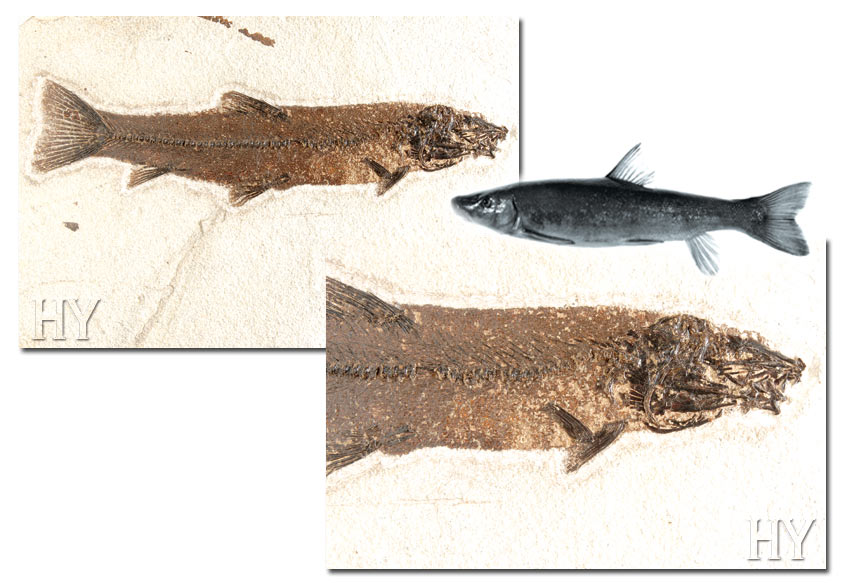 |
Sucker Fish Age: 54 to 37 million years old The sucker fish (Catostomidae) pictured is 54-37 million years old and has undergone no changes during this time. This fossil, identical to the sucker fish living in seas today, invalidates the theory of evolution. |
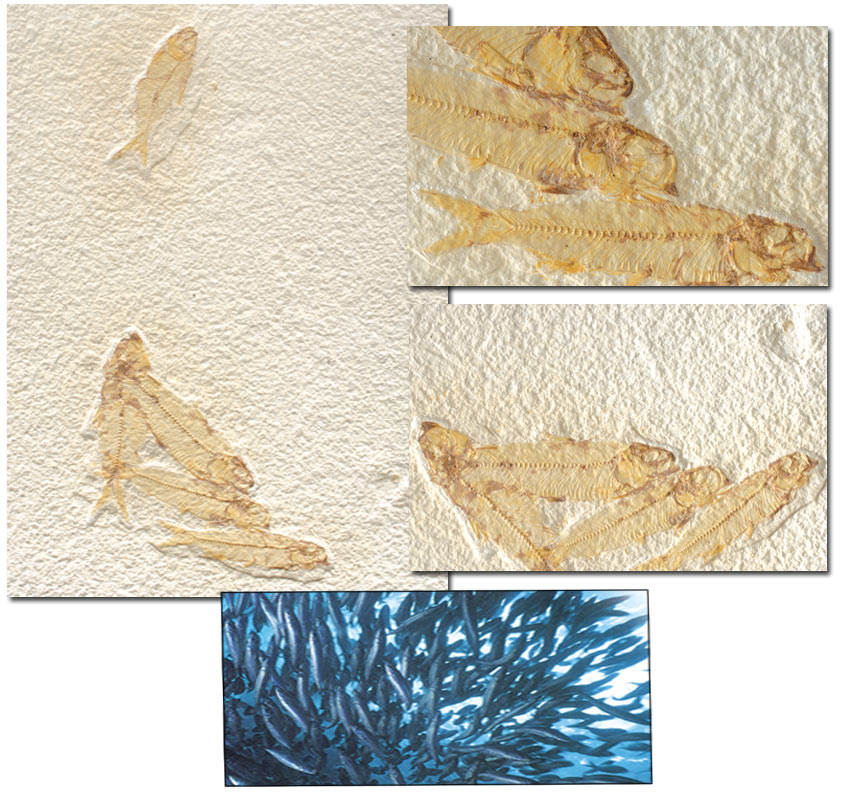 |
Herrings Age: 55 million years old Living fossils are no different from their counterparts that lived in ages past, and offer evidence that species have not undergone evolution for millions of years. The 55-million-year-old herrings pictured are some of these living fossils. |
 |
Ginkgo Leaf Age: 65 to 54 million years old Plants in the fossil records appear with features similar to plants alive today. This shows that they were created, like all other living things. |
 |
Herring Age: 55 million years old Although Darwinists choose not to admit it, the facts shown by fossil records are evident. Millions of fossils gathered from all over the world manifest that living beings did not evolve, but were created. One example showing this fact is the herring pictured. Herrings that have remained the same for millions of years once again show that the theory of evolution is a deception. |
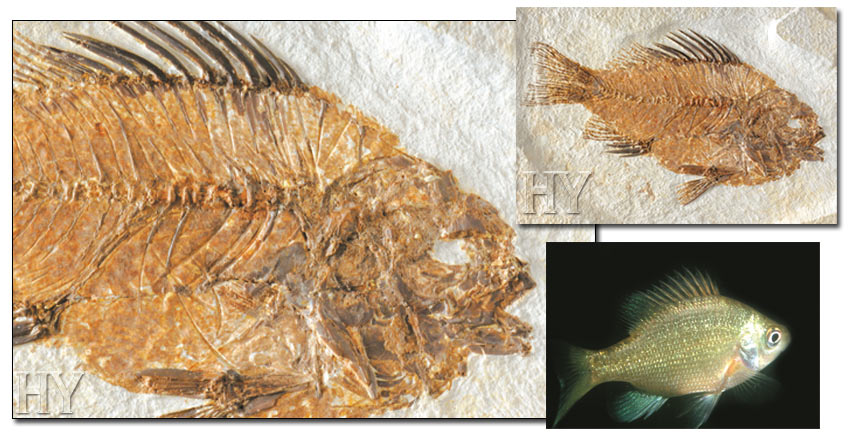 |
Sunfish Age: 54 to 37 million years old Seas in our day have many species of sunfish. The fossil pictured shows that sunfish have not evolved. For millions of years their physiology has remained the same. The appearance and structure of sunfish that lived about 55 million years ago are the same as those alive today. |
 |
Lamprey Age: 300 million years old Braidwood's coal mines are rich in fossils. The lamprey in the picture is a species lacking a jawbone. Although they generally live in shallow waters, some species make long journeys in oceans. |
 |
Trout-Perch Age: 50 million years old Evolutionists claim that fish evolved from invertebrates such as pikaia; that amphibians and today's fish evolved from a so-called ancestral fish. Reptiles evolved from amphibians, birds and mammals evolved from reptiles and finally, human beings and apes of today evolved from one common ancestor. But in order to prove this claim, they must be able to display the fossils of these transitional "missing links." But as stated earlier, there are no traces of these imaginary creatures. |
 |
Trout Tail Age: 15 million years old Some fossils preserve only certain parts of living beings' bodies. Pictured is a 15-million-year-old trout tail. As is seen, there is no difference between a trout tail 50 million years old and one that's 15 million years old and one that 's alive today. |
 |
Poplar Age: 15 million years old Poplar trees of the Salicaceae family have remained unchanged for millions of years. There are no differences between their organic and structural features they had initially and those they have now. This poplar leaf fossil dating back 15 million years proves this. |
 |
Crane Fly Period: Cenozoic Era, Eocene epoch As with all other species, stasis observed throughout the course of crane fly's existence is proof that evolutionary claims are false. The theory of evolution was proposed under the scientifically primitive conditions of the 19th century, adopted merely by ignorance, yet collapsed in the face of the 20th- and 21st-century science. |
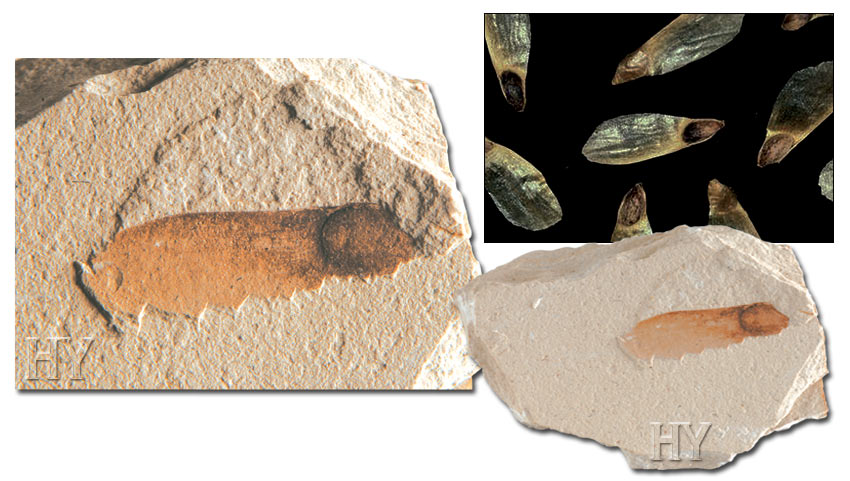 |
Spruce Age: 15 million years old "Spruce" is the general name given to 35 different species of trees that remain green throughout the year. Fossil records display that they have been the same for millions of years and have not undergone any evolution. The spruce seed fossil pictured dates back to 15 million years. As it also confirms, through millions of years that have gone by, spruce have always remained the same. There is no difference between spruces in our day and those alive 15 million years ago. |
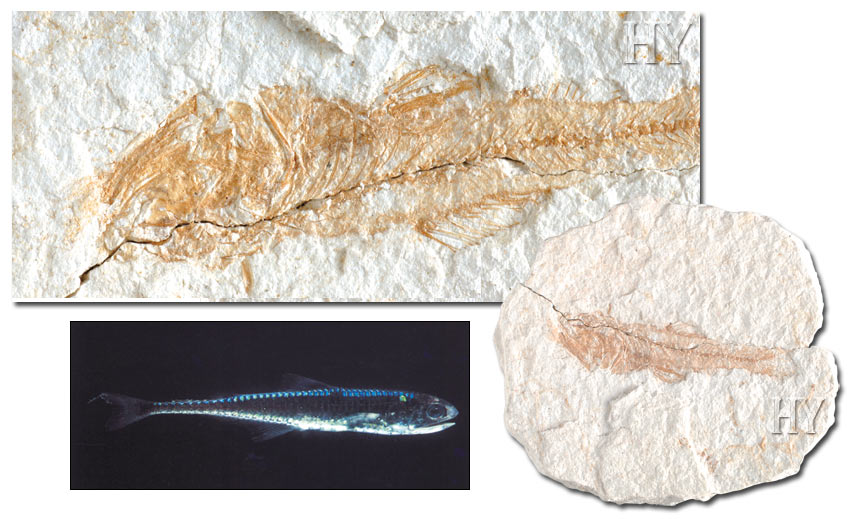 |
Lantern Fish Age: 23 to 5 million years old Lantern fish are small fish that live in the ocean deeps and produce light within their bodies, generally in their abdomens. Because they live in water that's deep and dark, they use their light both to illuminate their immediate environment and to scare their enemies. That these fishes' bodies have extremely advanced and complex bodily structures that can produce light in their bodies millions of years ago is inexplicable to evolutionists. |
 |
Ponderosa Pine Age: 15 million years The pine needle pictured is 15 million years old. Pine needles of 15 million years ago and those of today are identical. The fact that they remain the same despite the millions of years that have passed once again proves that evolution never existed. |
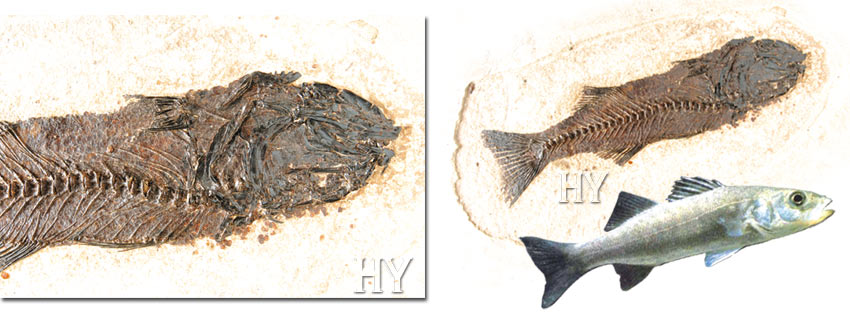 |
Perch Age: 54 to 37 million years old According to evolutionists' claims, the ancestors of fish were invertebrates, which lack backbones. However, evolutionists fail to answer how these ancestors with spines but no bones developed a backbone. That is because, these living beings should undergo such great changes that the hard shell surrounding their bodies should disappear while a skeleton appears inside. For such a transformation, there should be many intermediate links between the two organisms. However, evolutionists fail to show even a single fossil as an intermediate form between vertebrates and invertebrates. |
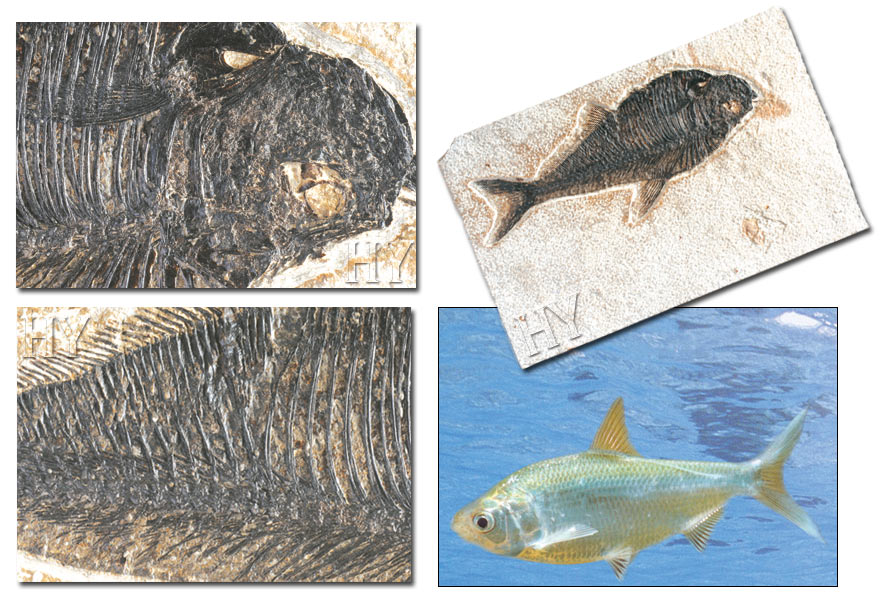 |
Herring Age: 55 million years old Herrings live in mild and shallow waters, mostly in the North Atlantic and Baltic Sea. Herrings that have approximately 200 species are almost the same. Almost all of them are silver in color and have a single fin on their backs. |
 |
Willow Age: 54 to 37 million years old As is the case with all other living things, the fossil record reveals that plants too have remained unchanged for millions of years. Today's plants have the same systems and mechanisms they did millions of years ago. The fossil willow leaf pictured is proof that willows have remained the same for 54 to 37 million years. |
 |
Poplar Leaf Period: Cenozoic Era, Eocene epoch This fossil specimen, evidence of the fact that poplars have always existed as poplars, is some 50 million years old. Poplars, having undergone no change at all over 50 million years, reveal that the theory of evolution is nothing but a deception and that evolution has never occurred. The universe, together with all the living things it contains, is the work of Almighty God. |
 |
Oak Leaf Age: 45 million years old Fossil records reveal that plants never underwent any evolutionary process and have no imaginary ancestors. Fish have always remained fish, birds have always remained birds, spiders have always remained as spiders, pines and spruces have always remained pines and spruces, and roses have always remained roses. And just like all these living beings, oaks have always remained as oaks, as the oak leaf fossil pictured confirms. |
 |
Wasp Period: Cenozoic Era, Eocene epoch Wasps that lived some 50 million years ago were no different from wasps living today. If there has been no changes whatsoever in the anatomy of a creature over the intervening tens of millions of years, then there is no evolution to talk about. The fossil record declares that evolution has never taken place. |
 |
Grape Leaf Age: 38 to 23 million years old The 38-23-million-year-old fossil grape leaf also verifies that plants also did not evolve, but were created. There exists no difference between Vitis grape leaves that existed millions of years ago and those of today. |
 |
Herring and Sunfish Age: 54 to 37 million years old These herring and sunfish specimens once again show that living beings have not evolved. These fossils on the same plate, between 54-37 million years old, reveal that the herrings and sunfish living today and those that lived in the past are no different. |
 |
Sumac Leaf Age: 54 to 37 million years old This 54-37-million-year-old sumac leaf is no structurally different from ones alive today. For millions of years, sumacs have undergone no changes. |
 |
North American Bear Skull Age: 50,000 years old Pointing out a few anatomical similarities between bears and dogs, evolutionists claim that both evolved from a common ancestor. Fossil records, on the other hand, reveal that this is not so. Not a single fossil belonging to a half dog/half bear creature has yet been found, although thousands of fossils show that bears were always bears and dogs were always dogs. The bear skull fossil pictured is evidence that bears have not undergone any evolution. |
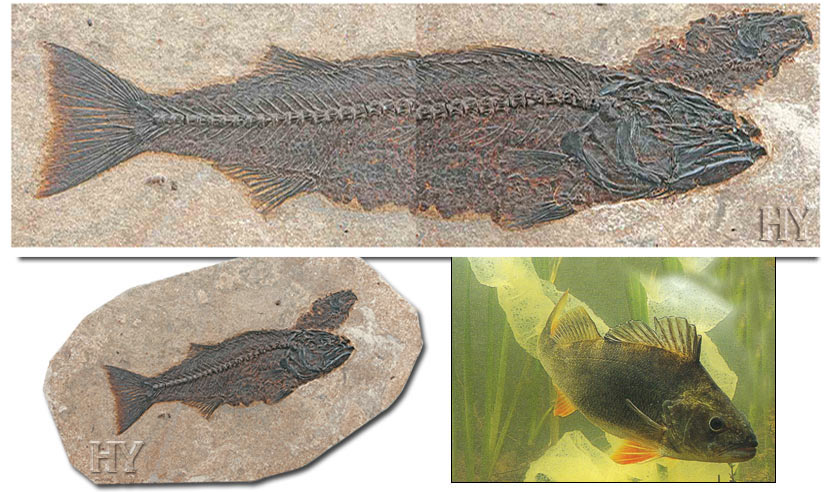 |
Perch Age: 54 to 37 million years old The 54- to 37-million-year-old perch is no different from those of today. Perches clearly have not evolved as evolutionists claim, but were created. |
 |
Sunfish Age: 54 to 37 million years old For 150 years, in every corner of the world, Darwinists have sought fossils that will offer evidence for the so-called evolution of fish. However every fossil discovered so far reveals that fish have not undergone any evolution, but were created. To date, evolutionists have found neither a living creature that may be the so-called ancestor of fish, nor any fossils representing the intermediary stages fish have supposedly undergone. On the contrary, hundreds of thousands of fossils show that throughout prehistory, fish have always remained as fish. One of them is the 54-37 million-year-old sunfish fossil pictured. Evolutionists are desperate in the face of these fossils that prove to be evidence of creation. |
 |
Hickory Leaf Age: 65 to 54 million years old This North American hickory leaf fossil, 65- to 54-million-year-old, is evidence that these trees did not evolve from another plant. Leaves of a hickory that lived millions of years ago and the ones that live today are identical. |
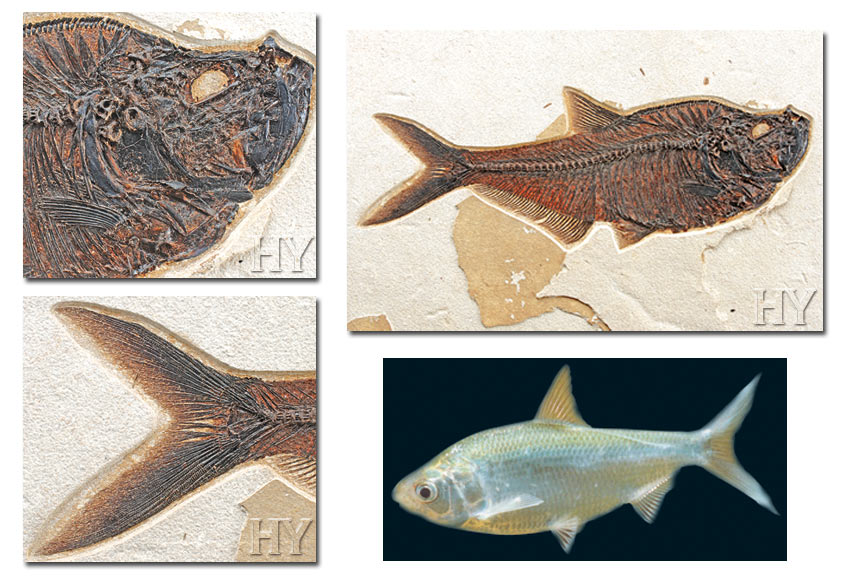 |
Herring Age: 54 to 37 million years old Herrings between 54 and 37 million years old are no different from the ones alive today. This invalidates the claims of evolutionists and once again confirms the fact that living beings are created by God. |
 |
Fig Leaf Age: 65 to 54 million years old The figs, plants with more than 800 species, are classified as Ficus. For millions of years, there have been no changes in the figs' leaves or their fruits. This is important evidence that figs have not evolved, as displayed by the fossil fig leaf pictured, 65 to 54 million years old. |
 |
Herrings Age: 54 to 37 million years old The theory of evolution is just an imaginary story written about the natural history of species but which scientific findings have definitely refuted. One of the most important findings that demolish the theory of evolution are fossils. Herrings that have remained unchanged for millions of years reveal that the theory of evolution is a deception. |
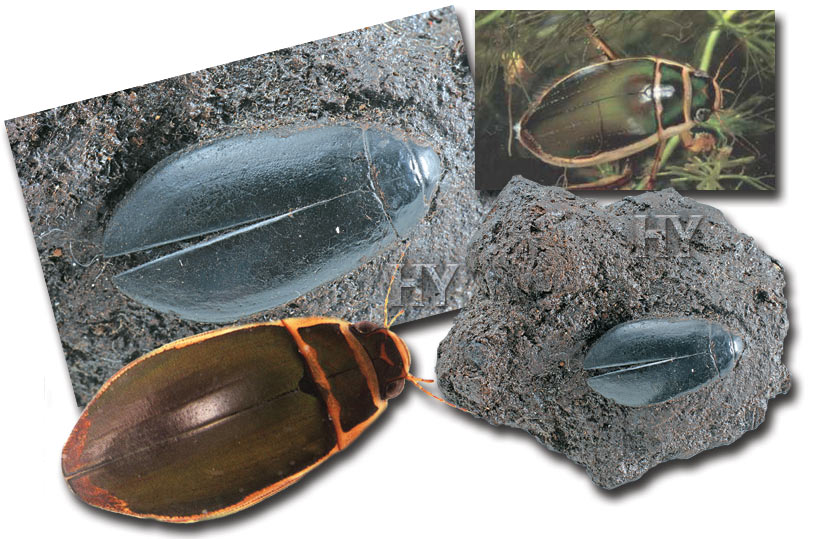 |
Water Beetle Age: 1.8 million to 11,000 years old This insect, no different from those living today, is evidence that all living beings have been created. |
 |
Horse Chestnut Leaf Age: 65 to 54 million years old The horse chestnut leaf that lived 65-54 million years ago is no different from the horse chestnut leaves of today. This is only one of the many pieces of evidence showing that plants have not evolved. |
 |
Fern Age: 360 to 286 million years old All the characteristics of ferns today were also shared by ferns that lived millions of years ago. Fossil records clearly reveal this. The 360 – 286 million-year-old fern pictured is the same as today's ferns. |
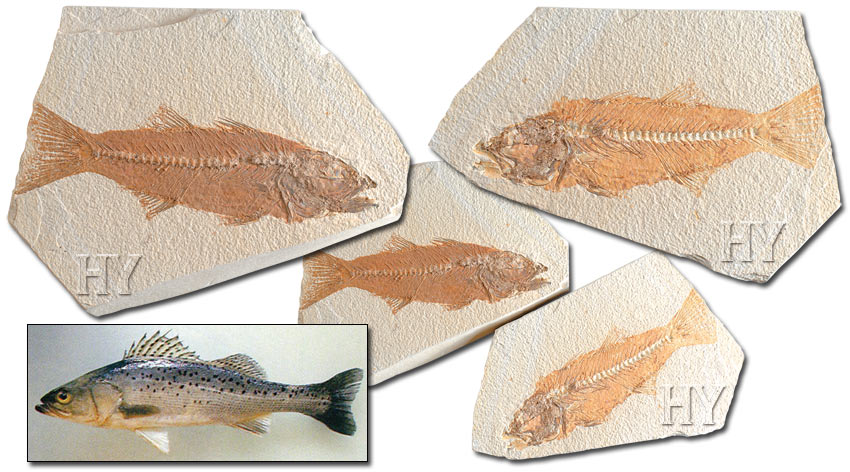 |
Perch Age: 54 to 37 million years old Among the millions of fossils discovered to date, there exists not one single "intermediate form" in the form of a half perch/half swordfish, half shark/half salmon. Fossils reveal that perches have always been perches, salmons have always been salmons, and sharks have always been sharks. The perch, which has been the same for 54-37 million years, also verifies this. |
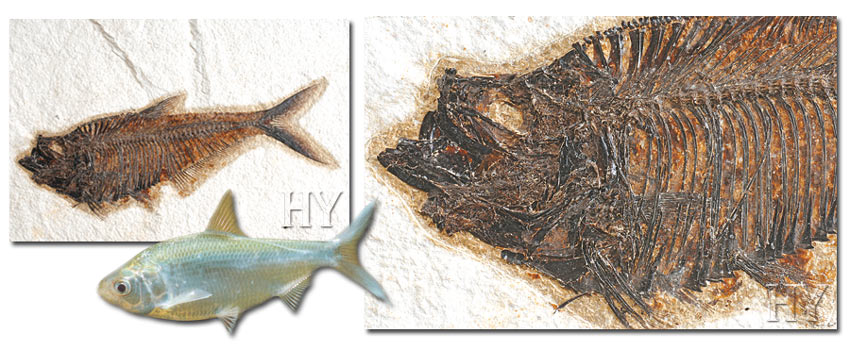 |
Herring Age: 54 to 37 million years old Current geological data reveal that fossil records are unusually rich. But this wealth of fossils provides no evidence to help evolutionists verify their claims. The entire fossil record confirms the fact of creation and denies evolution. The herring pictured is evidence that displays the invalidity of evolution. |
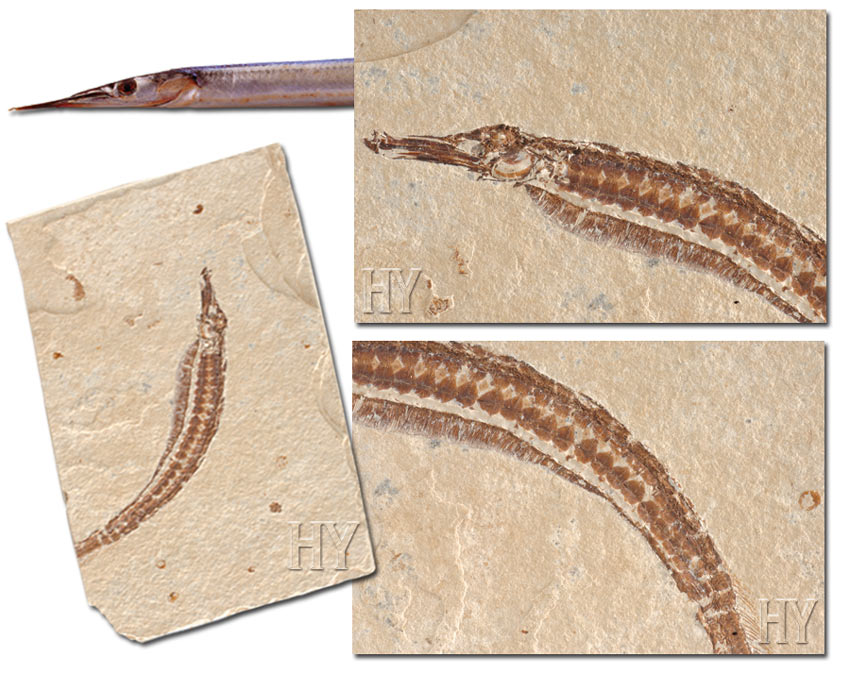 |
Pipefish Age: 23 to 5 million years old Pipefish is a small vertebrate that belongs to the same suborder (Syngathoidei) as seahorses. This fossil pipefish, between 23 and 5 million years old, is identical with those of today. This refutes Darwinists, who assert that living beings evolved gradually. |
 |
Grizzly Bear Skull Age: 89 million years old All organisms appear in the fossil record in perfect form, complete in all aspects, with no intermediate or missing organs or structures. There are no half-formed nor missing features in their skulls, vertebrae or limbs. While no findings show that grizzly bears were descended from or transformed into some other life form, numerous fossil specimens reveal how they always existed as grizzly bears. One such example is the 89-million-year-old skull pictured here. |
 |
Hackberry Leaf with a Cricket Period: Cenozoic Era, Eocene epoch In this picture there is a cricket fossilized with a hackberry leaf. This fossil, dramatizing that crickets and hackberries of some 50 million years ago were identical to the specimens of our day, condemns evolutionists to silence. Evolutionist speculations and propaganda are meaningless in the face of scientific findings. The truth science reveals is that evolution is a big lie, and that Creation is a clear fact. |
 |
Rhino Skull Age: 33 million years old The fossil pictured is evidence that no difference exists between rhinos of 33 million years ago and those today. Living creatures with anatomy unchanged for millions of years reveal that the theory of evolution is a huge deception. |
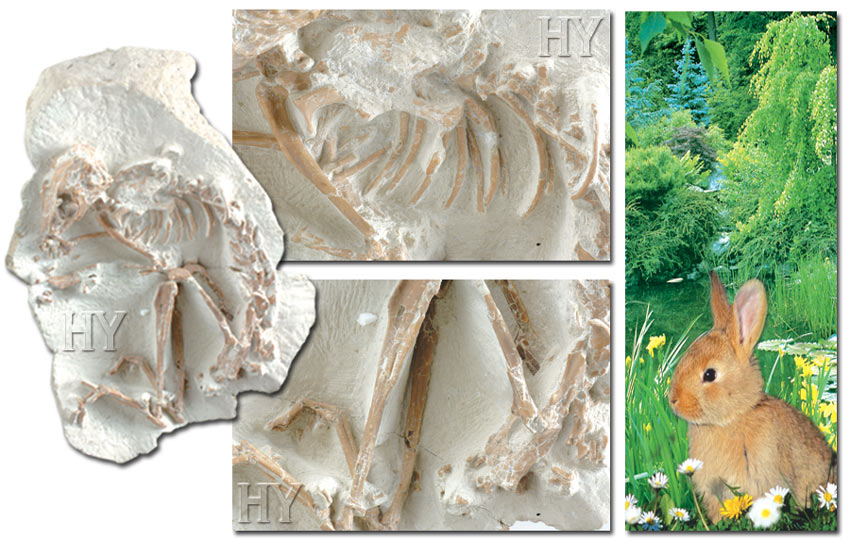 |
Rabbit Age: 33 million years old The fossil record contains no examples of species gradually evolving from other, earlier forms. For instance, among millions of fossils, there exists not a single one that possesses the features of a half crocodile/half rabbit or half snake/half rabbit. However, thousands of fossils show that rabbits have always been rabbits. The evident fact revealed by fossils is that living species did not evolve; God created them. |
 |
Sunfish, Herring Age: 54 to 37 million years old "Living fossils" that reveal that species have preserved their structures for millions of years deal a big blow to the theory of evolution. As is known, the theory of evolution maintains that only creatures able to adapt themselves to a changing environment can survive and in this process, they are able to evolve into other, distinct species. Living fossils, on the other hand, reveal that living beings do not evolve over time according to changing conditions—a groundless assertion. |
 |
Willow Age: 54 to 37 million years old Species of plants that exist for millions of years without undergoing any changes are a major blow to the theory of evolution. This fossil willow leaf, 54 to 37 million years old, has remained unchanged despite the passage of millions of years. The willow leaves of our day are the same as those that lived 54-37 million years ago. |
 |
Laurel Leaf Age: 54 to 37 million years old The leaves and fruits of the family Lauraceae (origin: Asia) are a source for oil, while their leaves may also be used as a spice. |
 |
Herring and Perch Age: 54 to 37 million years old This fossil, between 54 and 37 million years old, shows that herrings and perches have not changed for millions of years. There exists no difference between today's herring and perch and those that lived millions of years ago. |
 |
Rabbit Age: 38 to 23 million years old This rabbit that lived between 38 and 23 million years ago and rabbits that live today are the same. Rabbits have not changed for millions of years, proving that rabbits have not evolved, but were created. |
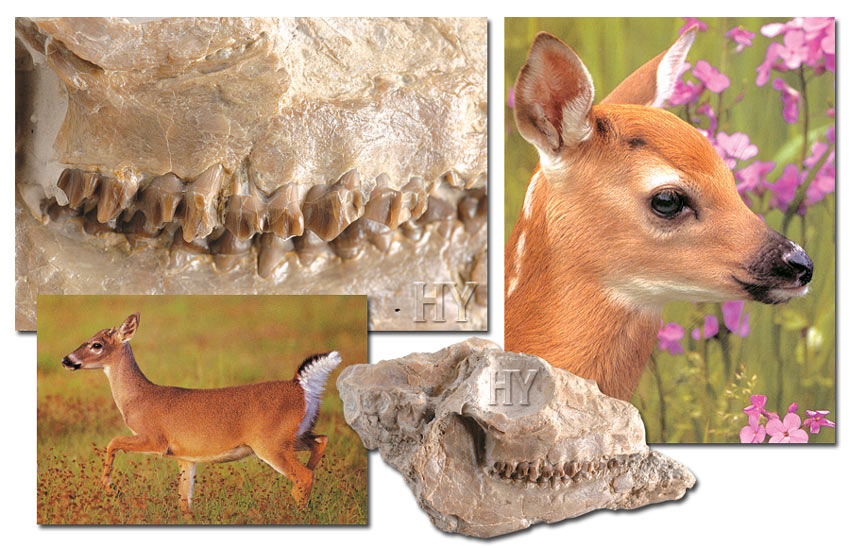 |
Deer Skull Age: 38 to 23 million years old The fact that deer 38-23 million years old are the same as those living today reveals that these mammals have not changed for millions of years—that is, they have not evolved. |
 |
Turtle Period: Cenozoic Era, Eocene epoch As did many other branches of science, paleontology also provided numerous findings and knowledge demonstrating how unscientific the prophecies of Darwin had actually been. One of these findings is the 54- to 37-million-year-old fossil turtle pictured here, which refutes evolutionists by evidencing that turtles have not changed at all over tens of millions of years. |
 |
Bivalve Age: 13 to 12.5 million years old Bivalves are two-shelled mollusks such as mussels and oysters. There is no difference between bivalves that lived millions of years ago and those of today—a situation that denies the gradual evolution suggested by Darwinists. |
 |
Turtle Age: 38 to 23 million years old Evolutionists admit that there is not a single finding in the fossil record to show that turtles ever underwent evolution. In his book Vertebrate Paleontology and Evolution, Robert Carroll says that the earliest turtles are encountered in Triassic formations in Germany and that these are easily distinguished from other species thanks to their hard shells, which are very similar to those of specimens living today. He then goes on to say that no trace of earlier or more primitive turtles has ever been identified,although turtles fossilize very easily and are easily recognized even if only very small parts are found. (Robert Carroll, Vertebrate Paleontology and Evolution, p. 207) |
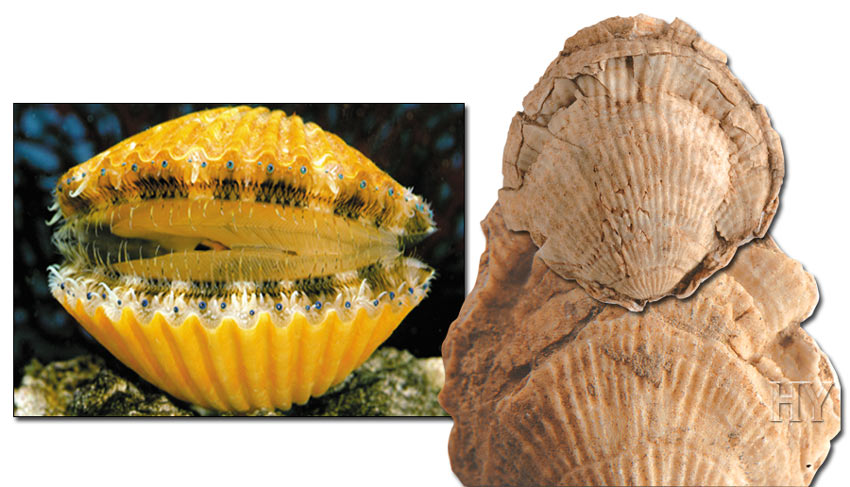 |
Bivalve Age: 410 to 360 million years old Bivalves that have remained the same for at least 360 million years challenge evolutionists who assert that species evolved gradually from one another. These fossil mollusks show that they did not evolve, but were created. |
 |
Sea Urchin Period: Paleozoic Era, Carboniferous period The sea urchin pictured is one of the innumerable pieces of evidence invalidating the evolutionary claims as to the origin of echinoderms. If the evolutionists’ claims were true, the sea urchin specimens of 306 to 209 million years ago should have been very different from today’s specimens. As this fossil demonstrates, however, there is no difference between living specimens and those of hundreds of millions of years ago. |
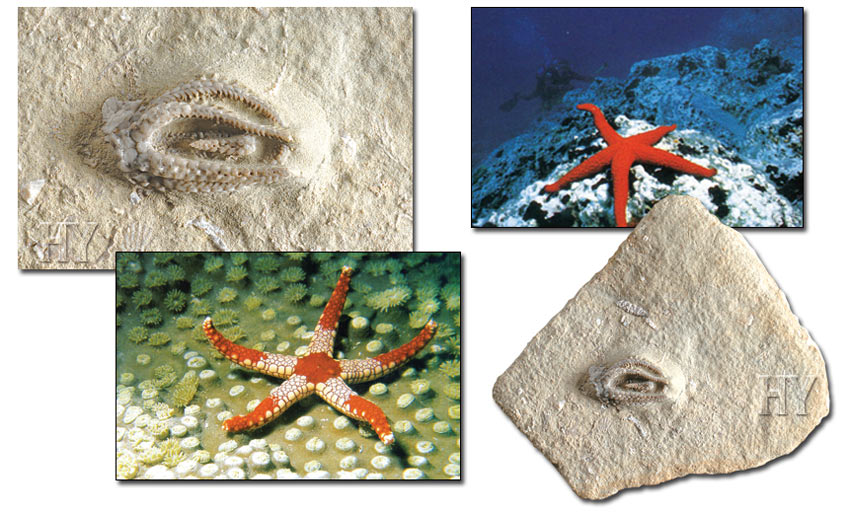 |
Starfish Age: 360 to 325 million years old Today's starfish possess the same characteristics as starfish of millions of years ago. This fossil, revealing that starfish have remained the same for 360 – 325 million years, refutes the claims of evolutionists and show that living things were created with the same features they still have. |